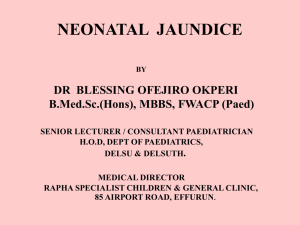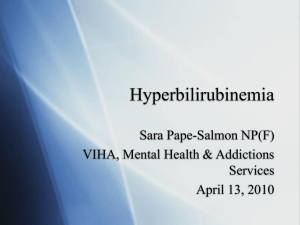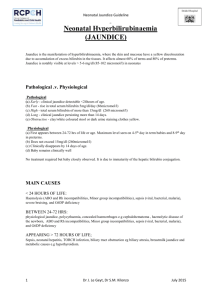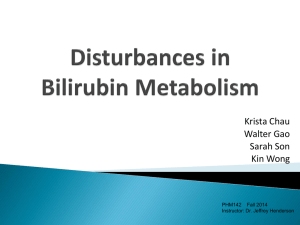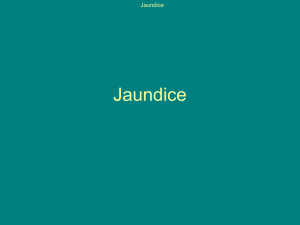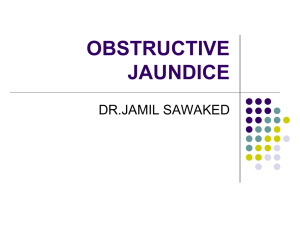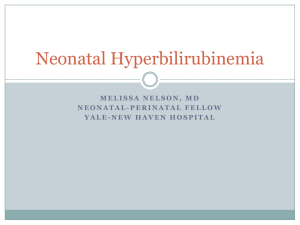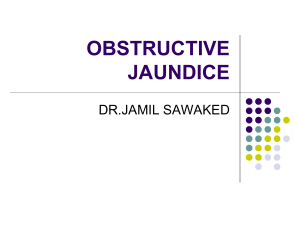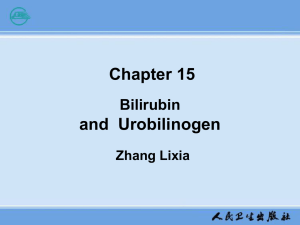Hyperbilirubinemia
advertisement
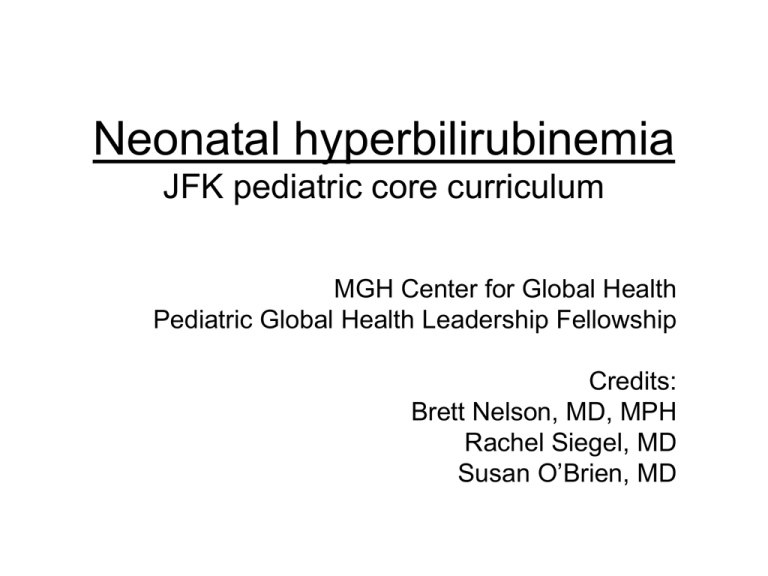
Neonatal hyperbilirubinemia JFK pediatric core curriculum MGH Center for Global Health Pediatric Global Health Leadership Fellowship Credits: Brett Nelson, MD, MPH Rachel Siegel, MD Susan O’Brien, MD Discussion outline • Bilirubin pathophysiology • Physiologic and non-physiologic jaundice • Causes of non-physiologic jaundice – Unconjugated hyperbilirubinemia – Conjugated hyperbilirubinemia • Workup • Treatment Bilirubin pathophysiology • Bilirubin is breakdown product of heme, from circulating RBCs • Carried by albumin to hepatocytes, where processed for excretion • In hepatocytes, uridine diphosphogluconurate glucuronosyltransferase (UGT) catalyzes conjugation of bilirubin with glucuronic acid • Conjugated bilirubin is now more water soluble and can be excreted in bile (and urine) Bilirubin pathophysiology Epidemiology: neonatal jaundice • Neonatal jaundice is quite common – >50% of normal newborns and – 80% of preterm infants have some degree of jaundice • Two types of neonatal jaundice: – Normal / physiological – Abnormal / non-physiological Reasons for physiologic jaundice • In term newborns, bilirubin production is 2-3 times higher than in adults – Hematocrit of 50-60%, shorter RBC life span (90 days), and increased turnover of RBCs • Bilirubin clearance decreased in newborns, mainly due to deficiency of enzyme UGT – UGT activity in term infants at 7 days is ~1% of adult liver and doesn’t reach adult levels until 14 weeks • Increase enterohepatic circulation of bilirubin, further increasing bilirubin load Greater concerns in preterm infants • Even more RBC turnover and destruction • Physiologically impaired conjugation and elimination of bilirubin – An even less mature liver – Reduced bowel motility due to inadequate oral intake – Delayed elimination of meconium – Increased enterohepatic circulation Physiologic jaundice • • • • • Jaundice appears around 72 hrs of life Bilirubin peaks <14 mg/dl Direct bilirubin <10% of total bilirubin Rate of rise <5mg/dL/day Jaundice resolves in 1-2 weeks in term infants, 2 weeks in preterm infants • Otherwise the jaundice is abnormal… Two forms of hyperbilirubinemia • Unconjugated / indirect hyperbilirubinemia: – Pre-hepatic cause, or impairment in conjugation VS. • Conjugated / direct hyperbilirubinemia: – Injury at the level of the hepatocytes, or post-hepatic obstruction – Consider diagnosis of conjugated hyperbilirubinemia if direct bilirubin is >3mg/dL, or is >10% of total bilirubin Non-physiologic jaundice • Early jaundice – Starts on first day of life • Jaundice of long duration – >14 days in term or >21 days in preterm infants • Deep jaundice – Palms and soles deep yellow – Objectively, high bilirubin lab levels • Jaundice with fever Differential diagnosis: Unconjugated hyperbilirubinemia • Breastfeeding jaundice – • Breast milk jaundice – • ABO/Rh incompatibility RBC membrane defects Alpha thalassemia G6PD deficiency Cephalohematoma Polycythemia Infection Hypothyroidism Gilbert’s – • Occurs at 4-10 days of age; substance in breast milk inhibits glucuronyl transferase (treat by temporary switch to formula) Hemolysis – – – – – – • • • Occurs at 1-3 days of age; due to dehydration and lack of stooling (treat by increasing feeding frequency) impaired conjugation, associated with stress, no overt hemolysis Crigler-Najjar’s – absent (type 1) or diminished (type 2) UDP-glucoronyl transferase Differential diagnosis: Conjugated hyperbilirubinemia • Biliary atresia – ~60% of cases; an obliterative process of bile ducts; diagnosed by U/S or biopsy • Infection – Hepatitis B, TORCH • Metabolic – Galactosemia – Alpha-1-antitrypsin deficiency: most common genetic cause – Dubin Johnson or Rotor’s syndrome: defective liver secretion of bilirubin • Iatrogenic – Drug-mediated – TPN-related: occurs in ~2/3 of infants given TPN over 2 weeks of duration; unknown mechanism, possibly mediated by bacterial endotoxins, oxidative stress, glutathione depletion • Idiopathic – neonatal non-infectious hepatitis (diagnosis of exclusion) The concern: Kernicterus • Bilirubin exceeds albuminbinding capacity, crosses BBB, and deposits on basal ganglia and brainstem nuclei • Risks increase with levels >20 mg/dl – Or lower levels in setting of sepsis, meningitis, hemolysis, hypothermia, hypoglycemia, or prematurity Signs of kernicterus • Acute sequelae: – Poor suck, lethargy, hypotonia, seizure – Then hypertonia (opisthotonus, retrocollis), fever, high-pitched cry • Chronic sequelae: – Choreoathetoid CP, gaze paresis, sensorineural hearing loss, mental retardation Cause analysis of kernicterus • Early discharge <48hrs without follow-up within 48hrs • Failure to check bilirubin level when jaundice within 24hrs of life • Failure to recognize risk factors • Underestimating severity by visual assessment • Delay in initiating treatment • Failure to respond to parental concerns AAP Subcommittee on Neonatal Hyperbilirubinemia. Pediatrics 2001; 108: 763-765. Work up: assess risk factors • Maternal: – Race or ethnic group (Asian, Mediterranean) – ABO, Rh incompatibility – Previous jaundiced infant – Advanced maternal age – Diabetes • Infant: – – – – – – Gestation <38 weeks Bruising, cephalohematoma Infection G6PD deficiency Polycythemia Male gender • Nutritional: – Breastfeeding – Weight loss – Decreased feeding frequency – Decreased stooling – Decreased urine output Work up: laboratory studies • Where possible, confirm clinical jaundice with bilirubin levels • Possible additional investigations, depending on likely diagnoses and lab availability: – – – – Hemoglobin/hematocrit (PCV) to look for hemolysis Blood smear Reticulocyte count WBC to look for signs of infection (WBC <5, WBC>20, or I:T ratio >20%) – Blood type of baby and mother, and Coombs test – Syphilis serology (e.g. VDRL) – G6PD screen, thyroid function tests, liver ultrasound Treatment options: Unconjugated hyperbilirubinemia • Hydration / feeding – Consider formula supplementation with temporary interruption of breastfeeding • Phototherapy… (see next slide) • Antibiotics if suspected infection • Antimalarials if fever and positive smear • (Exchange transfusion) • (IVIG in immune-mediated red cell destruction) Diagnosis of jaundice can be very difficult in dark-skinned babies Scleral icterus may be more sensitive marker but is a later sign High level of suspicion is required! Phototherapy • Clinical indications1: – Jaundice on day 1 – Jaundice in premature infant – Deep jaundice involving palms and soles of the feet • Laboratory indications: – In full-term infants, bilirubin levels per Bhutani curves – In premature infants, when bilirubin level ≥5x weight (e.g. threshold for 3kg newborn = 3kg x 5 = 15mg/dl) 1. Pocket Book of Hospital Care for Children. WHO. 2005. Bhutani curve: identifying risk Nomogram for designation of risk in 2840 well newborns at 36 or more weeks' gestational age with birth weight of 2000 g or more or 35 or more weeks' gestational age and birth weight of 2500 g or more based on the hour-specific serum bilirubin values. (Subcommittee on Hyperbilirubinemia, Pediatrics 2004;114:297-316) Bhutani curve: phototherapy Guidelines for phototherapy in hospitalized infants of 35 or more weeks' gestation. (Subcommittee on Hyperbilirubinemia, Pediatrics 2004;114:297-316) WHO guidelines: phototherapy Pocket Book of Hospital Care for Children. WHO. 2005. Key points regarding treatment: • Bilirubin levels above 20 are an emergency that need to be treated emergently • Multiple unit phototherapy, up to 6-8 lights, if they are available, can and should be used • If bilirubin is high, need to provide multi-unit therapy, encouragement of frequent feeding and possibly IV fluids as well Treatment: Conjugated hyperbilirubinemia • Phototherapy is contraindicated • Treat underlying cause • Phenobarbital – increases conjugation and excretion of bilirubin; however, could affect cognitive development, therefore used cautiously • Ursodiol – increases biliary flow and improves cholestatic jaundice Conclusion • Neonatal jaundice is a very common condition • Important to prevent kernicterus • Pathologic jaundice is early, deep, quickly progressing, or of long duration • Assess jaundice through identifying risk factors and laboratory analysis • Bhutani curves guide phototherapy treatment for unconjugated hyperbilirubinemia • Treat underlying cause of conjugated hyperbilirubinemia
